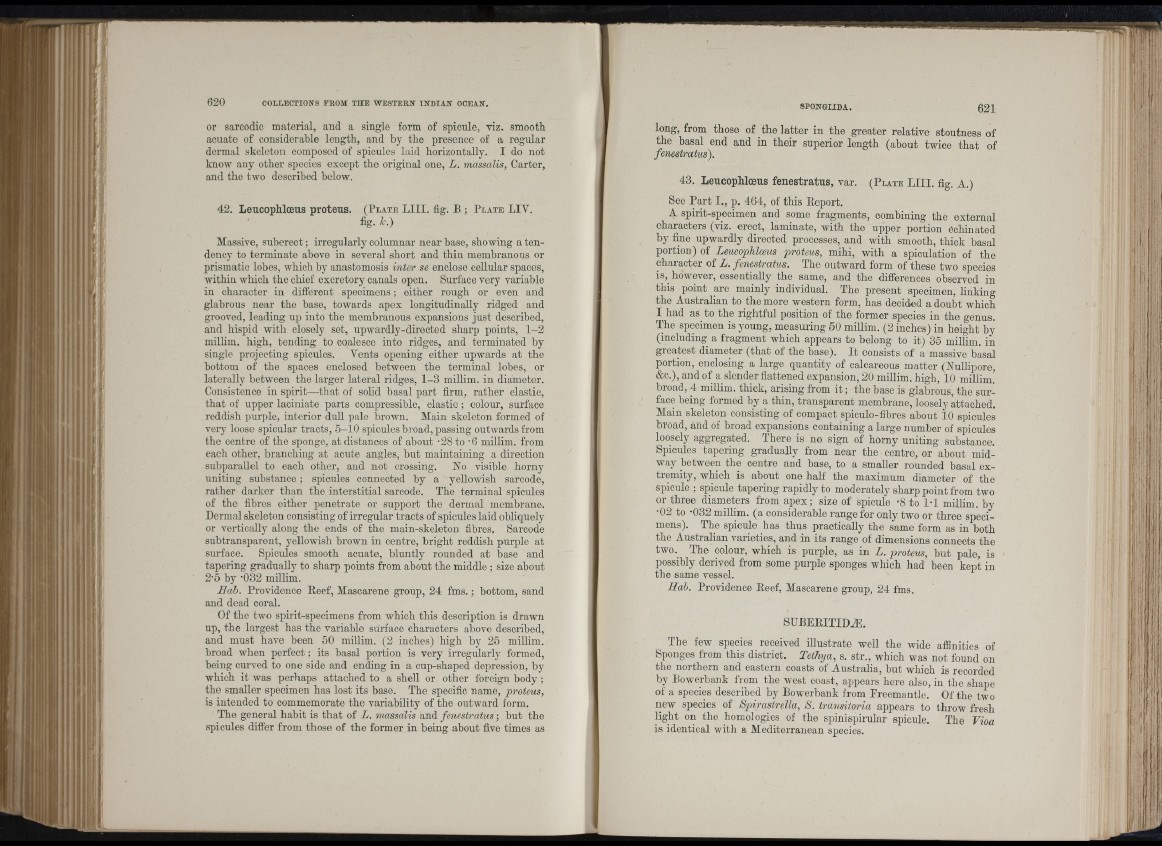
or sarcodic material, and a single form of spicule, viz. smooth
acuate of considerable length, and by tbe presence of a regular
dermal skeleton composed of spicules laid horizontally. I do not
know any other species except tbe original one, L. massalis, Carter,
and tbe two described below.
42. Leucophloeus proteus.
; H
i Í 1
( P l a t e L I II . f l g . B ; P l a t e LIV.
f i g . k.)
Massive, suberect ; irregularly columnar near base, showing a tendency
to terminate above in several short and thin membranous or
prismatic lobes, which by anastomosis intei- se enclose cellular spaces,
within which the chief excretory canals open. Surface very variable
in character in diiferent specimens; either rough or even and
glabrous near tbe base, towards apex longitudinally ridged and
grooved, leading up into the membranous expansions just described,
and hispid with closely set, upwardly-directed sharp points, 1-2
millim. high, tending to coalesce into ridges, and terminated by
single projecting spicules. Vents opening either upwards at the
bottom of the spaces enclosed between tbe terminal lobes, or
laterally between tbe larger lateral ridges, 1 -3 millim. in diameter.
Consistence in spirit—that of solid basal part firm, rather elastic,
th at of upper laciniate parts compressible, elastic ; colour, surface
reddish purple, interior duU pale brown. Main skeleton formed of
very loose spicular tracts, 5-10 spicules broad, passing outwards from
the centre of the sponge, at distances of about -28 to ’6 millim. from
each other, branching at acute angles, but maintaining a direction
subparallel to each otber, and not crossing. No visible horny
uniting substance ; spicules connected by a yellowish sarcode,
ratber darker than tbe interstitial sarcode. The terminal spicules
of the fibres either penetrate or support the dermal membrane.
Dermal skeleton consisting of irregular tracts of spicules laid obliquely
or vertically along the ends of tbo main-skeleton fibres. Sarcode
suhtransparent, yellowish brown in centre, bright reddish purple at
surface. Spicules smooth acuate, bluntly rounded a t base and
tapering gradually to sharp points from about the middle ; size about
2-5 by ’032 millim.
Hah. Providence Beef, Mascarene group, 24 fms. ; bottom, sand
and dead coral.
Of the two spirit-specimens from which this description is drawn
up, tbe largest has tbe variable surface characters above described,
and must bave been 50 millim. (2 iucbes) high by 25 millim.
broad wben perfect ; its basal portion is very irregularly formed,
being curved to one side and ending in a cup-sbaped depression, by
which it was perhaps attached to a shell or other foreign body ;
tbe smaUer specimen has lost its base. Tbe specific name, proteus,
is intended to commemorate the variability of the outward form.
Tbe general habit is th at of L . massalis and fenestratus ; but tbe
spicules differ from those of the former in being about five times as
621
long, from those of the latter in tbe greater relative stoutness of
the basal end and in tbeir superior length (about twice th at of
fenestratus).
43. Leucophloeus fenestratus, var. (P late L III. fig. A.)
See P a rt I., p. 464, of this Beport.
A spirit-specimen and some fragments, combining tbe external
characters (viz. erect, laminate, with tbe upper portion echinated
by fine upwardly directed processes, and with smooth, thick basal
portion) of Leucophloeus proteus, mihi, with a spiculation of tbe
character of L. fenestratus. The outward form of tbese two species
i/_ however, essentially tbe same, and tbe differences observed in
this point are mainly individual. Tbe present specimen, linking
tbe Australian to the more western form, bas decided a doubt which
I bad as to tbe rightful position of the former species in tbe genus.
The specimen is young, measuring 50 millim. (2 inches) in beigbt by
(including a fragment wbicb appears to belong to it) 35 millim. in
greatest diameter (tbat of the base). I t consists of a massive basal
portion, enclosing a large quantity of calcareous matter (Nullipore,
&c.), and of a slender flattened expansion, 20 millim. high, 10 millim!
broad, 4 millim. thick, arising from it ; tbe base is glabrous, tbe sur^
face being formed by a thin, transparent membrane, loosely attached.
Main skeleton consisting of compact spiculo-fibres about 10 spicules
broad, and of broad expansions containing a large number of spicules
loosely aggregated. There is no sign of horny uniting substance.
Spicules tapering gradually from near tbe centre, or about midway
between tbe centre and base, to a smaller rounded basal extremity,
which is about one half tbe maximum diameter of tbe
spicule ; spicule tapering rapidly to moderately sharp point from two
or three diameters from apex; size of spicule -8 to 1-1 milbm. by
•02 to -032 miilim. (a considerable range for only two or three specimens).
Tbe spicule bas tbus practically the same form as in botb
tbe Australian varieties, and in its range of dimensions connects tbe
two. Tbe colour, wbicb is purple, as in L. proteus, but pale, is
possibly derived from some purple sponges wbicb had been kept in
the same vessel.
Hah. Providence Beef, Mascarene group, 24 fms.
SU B EB IT ID ^ .
The few species received illustrate well the wide afllnities of
Sponges from tbis district. Tethya, s. str., which was not found ou
tbe northern and eastern coasts of Australia, but which is recorded
by Bowerbank from tbe west coast, appears here also, in the shape
of a species described by Bowerbank from Ereemantle. Of tbe two
new species of Spirastrella, S . transitoria appears to throw fresb
bgbt on the homologies of the spinispirular spicule. Tbe Vioa
is identical with a Mediterranean species.